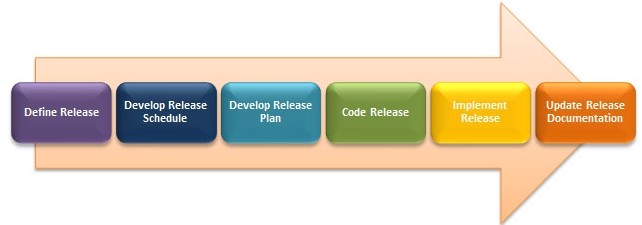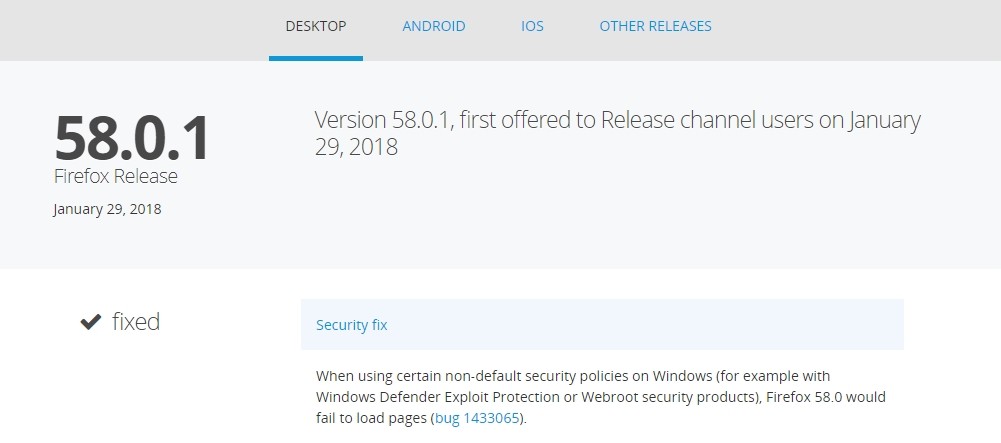Managing release is simple: release management rules and steps
The release is one of the most important and expected events in the product life cycle. Release preparations can take a lot of effort and time, the participation of the whole team and stakeholders. Well, if the release of the product or its version runs smoothly and becomes a real holiday. But it happens otherwise. What is effective release management and how can product managers learn its secrets?

The release is associated with the launch of a new product / service / service or a set of new functions, changes that are available to customers or users and provide a new product value.
Often a release consists of a series of solutions to fix problems and improve the services provided, which may include changes to the software. In fact, this is a fairly significant event for both the internal teams and the target audience.
')
Release management helps teams plan their work and see the end result, and for clients this is a kind of guarantee of quality and getting new value.
A well-prepared release is not only providing access to new technical capabilities of the product. This is the final date when your team can provide a new user experience, support and develop interaction with it.
Releases should include all additional tasks and activities, such as updates on the official website and on social networks, support team training, updating all marketing materials, etc.
The main goal of release management is to create, test and deliver new features that will satisfy all product requirements and intended goals.
Product teams should plan releases carefully, as they are a new offering that customers expect.
Understanding the release management process may vary between developers and non-technical experts. It is important to consider all aspects of the release and listen to the opinions of each team member.
The release management process may include the following steps:

Virtually all team members can participate in product release management.
Product managers and project managers are primarily responsible for the release. The functional product manager project and manager is different , but their mission is the same - to release the product and present it to customers in an ideal way.
Development teams are key players in release management, as they are involved in most processes in the product life cycle. They estimate the initial costs and time, determine the basic requirements, create the documentation and develop the functionality. They make major decisions about what can be done and what is not needed, as well as how long it will take.
Marketers should always “keep abreast of” and be aware of what competitors live. In release management, it is important for them to work closely with sales managers to get new customers and retain existing customers.
Testers work together with developers. Their task is to test the results of research and development based on established criteria. The product will not come to release until all the comments and criteria for testing are taken into account.
The support team or individual support specialist is the first to receive messages if something has gone wrong. They must understand and know everything about the release and must be properly prepared at all levels at the planning stage.
In addition to these main roles, other specialists may also be involved in release management: the purchasing department, financiers, sales, billing, system engineering, and others.
Release Notes are product release notes that describe the changes between the release and the previous versions of this product. Such a document can be compiled for users and for internal teams: testers, marketers, support services.
The main objectives of the documents are:
The tracking system or one of the popular tools for product management, such as the Hygger.io platform, can help with the release notes .
Release Notes are distributed with the products. Sometimes - when products are still in development or testing. The document can be delivered to customers upon release of an update (for products that have already been used by customers).
You can find various spellings of the Release Notes, since there is no single standard or format for this document. In different companies, product managers, testers, and developers, who are usually responsible for writing notes, usually use their own templates.
Here’s what the Firefox release notes page looks like:

The content of the document depends on the type of release. Here is an example of the main points:
Release management in many companies becomes a separate independent process that informs the customer of the product release date and the main stages of its development. The customer participates in prioritization and is involved in determining the content of the release.
The process allows product managers and the team to assess the load in a timely manner and manage the scope of work, deliver changes on time. Release management allows you to collect your own statistics, with which it is more convenient to further justify requests for additional resources.
If you want to understand the release management topic in more detail and find interesting insights from different companies, the following books will be useful: (in English)
IT release management . By Dave Howard
Release it! Design and deploy production . Author - Michael Nygard
Enterprise release management . The author is Gerardus Blokdyk.
Software Change Configuration and Release Management . The author is Gerard Blokdyk.
Z-os Release Management RED-HOT Career Guide . Editorial Red-Hot Careers
Agile Product Management: Release Planning . The author is Paul Vii.
Simple ways of handling release management process . The author is Prasenjit Das.
Dissecting Two Disciplines - Release and Deployment Management . Authors - Troy Pesola, Andrea Pesola.

The release is associated with the launch of a new product / service / service or a set of new functions, changes that are available to customers or users and provide a new product value.
Often a release consists of a series of solutions to fix problems and improve the services provided, which may include changes to the software. In fact, this is a fairly significant event for both the internal teams and the target audience.
')
Release management helps teams plan their work and see the end result, and for clients this is a kind of guarantee of quality and getting new value.
A well-prepared release is not only providing access to new technical capabilities of the product. This is the final date when your team can provide a new user experience, support and develop interaction with it.
Releases should include all additional tasks and activities, such as updates on the official website and on social networks, support team training, updating all marketing materials, etc.
The main goal of release management is to create, test and deliver new features that will satisfy all product requirements and intended goals.
Product teams should plan releases carefully, as they are a new offering that customers expect.
What does the release management process include?
Understanding the release management process may vary between developers and non-technical experts. It is important to consider all aspects of the release and listen to the opinions of each team member.
The release management process may include the following steps:
- Planning . The entire product path begins with its planning and strategy, and release planning allows you to calculate and determine the number of sprints or iterations. At this stage, an initial prioritization, a preliminary assessment of costs and an analysis of interdependencies occur. Analytics and the customer are involved in planning. Planning includes expectations of major product changes that may be reflected in the product roadmap .
- Reconcile . At this stage, we get confirmation of the resources from the performers and customers, and the release budget is evaluated. The content of the release is finally consistent with all interested parties.
- Documentation . This process of consolidation and systematization of all procedures, which reflect, for example, the latest data on new features.
- Communication and support . For each product manager it is very important not only to successfully launch a product or update, but also to ensure smooth interaction with the support team.
- Readiness status . The release status is reflected in the current status of your plan. Status update helps reduce risks and ensure communication with stakeholders.
- Testing / Adjustments . In the process of managing the release can not do without regular checks and adjustments that help to achieve order and achieve the final goal.
- Deploy . At this stage, the changes are transferred to operation. There is a new version of the product or the final product itself.

Virtually all team members can participate in product release management.
Product manager and Project Manager
Product managers and project managers are primarily responsible for the release. The functional product manager project and manager is different , but their mission is the same - to release the product and present it to customers in an ideal way.
Handlers
Development teams are key players in release management, as they are involved in most processes in the product life cycle. They estimate the initial costs and time, determine the basic requirements, create the documentation and develop the functionality. They make major decisions about what can be done and what is not needed, as well as how long it will take.
Marketing
Marketers should always “keep abreast of” and be aware of what competitors live. In release management, it is important for them to work closely with sales managers to get new customers and retain existing customers.
Testers
Testers work together with developers. Their task is to test the results of research and development based on established criteria. The product will not come to release until all the comments and criteria for testing are taken into account.
Support
The support team or individual support specialist is the first to receive messages if something has gone wrong. They must understand and know everything about the release and must be properly prepared at all levels at the planning stage.
In addition to these main roles, other specialists may also be involved in release management: the purchasing department, financiers, sales, billing, system engineering, and others.
Why do I need to implement a release management process?
- Release control allows you to make timely changes in the IT environment without adversely affecting the quality of the product.
- Reduce possible incompatibilities of new features with software.
- Testing allows you to identify and prevent potential problems for users.
- Release management reduces the number of uncontrolled software versions.
What are Release Notes in the release management process?
Release Notes are product release notes that describe the changes between the release and the previous versions of this product. Such a document can be compiled for users and for internal teams: testers, marketers, support services.
The main objectives of the documents are:
- informing users about the corrected errors, expanding the functionality of the product.
- Paying attention testers to check errors, fix them.
- preparation of changes in user manuals and product training materials.
The tracking system or one of the popular tools for product management, such as the Hygger.io platform, can help with the release notes .
When are release notes used?
Release Notes are distributed with the products. Sometimes - when products are still in development or testing. The document can be delivered to customers upon release of an update (for products that have already been used by customers).
You can find various spellings of the Release Notes, since there is no single standard or format for this document. In different companies, product managers, testers, and developers, who are usually responsible for writing notes, usually use their own templates.
Here’s what the Firefox release notes page looks like:

How to write release notes?
The content of the document depends on the type of release. Here is an example of the main points:
- Title with the product name, release date and number, version of the note.
- Brief information - product overview and changes.
- Links to installation instructions, user manual, archive, if necessary.
- Goals - a brief overview of the goals of the release notes with a listing of the new in this version (bug fixes and new features).
- Summary - a brief description of errors and problems.
- Steps to eliminate errors.
- The solution is an optimization that was made to correct errors.
- Impact users and support, if necessary.
- Notes - all notes regarding the installation of the product, its updates and documentation.
- Legal information - licenses, guarantees, disclaimers, etc.
- Contacts - contact information for product support.
Conclusion
Release management in many companies becomes a separate independent process that informs the customer of the product release date and the main stages of its development. The customer participates in prioritization and is involved in determining the content of the release.
The process allows product managers and the team to assess the load in a timely manner and manage the scope of work, deliver changes on time. Release management allows you to collect your own statistics, with which it is more convenient to further justify requests for additional resources.
If you want to understand the release management topic in more detail and find interesting insights from different companies, the following books will be useful: (in English)
IT release management . By Dave Howard
Release it! Design and deploy production . Author - Michael Nygard
Enterprise release management . The author is Gerardus Blokdyk.
Software Change Configuration and Release Management . The author is Gerard Blokdyk.
Z-os Release Management RED-HOT Career Guide . Editorial Red-Hot Careers
Agile Product Management: Release Planning . The author is Paul Vii.
Simple ways of handling release management process . The author is Prasenjit Das.
Dissecting Two Disciplines - Release and Deployment Management . Authors - Troy Pesola, Andrea Pesola.
Source: https://habr.com/ru/post/358204/
All Articles